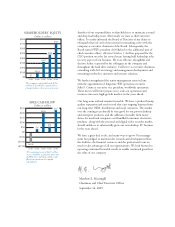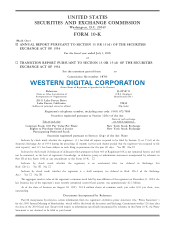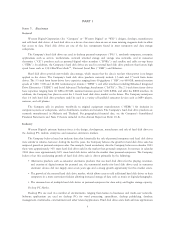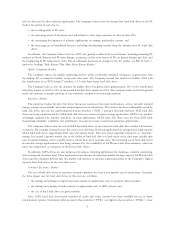Western Digital 2005 Annual Report Download - page 15
Download and view the complete annual report
Please find page 15 of the 2005 Western Digital annual report below. You can navigate through the pages in the report by either clicking on the pages listed below, or by using the keyword search tool below to find specific information within the annual report.Retailers. The Company sells its retail-packaged products directly to a select group of major retailers such as
computer superstores, warehouse clubs and computer electronics stores, and authorizes sales through distributors to
smaller retailers. Retailers accounted for approximately 6%, 7% and 8% of the Company's revenue for each of 2005,
2004 and 2003, respectively. The Company's current retail customer base is primarily in the United States, Canada and
Europe. The retail channel complements the Company's other sales channels while helping to build brand awareness for
the Company and its products. Retailers supply the aftermarket ""upgrade'' and data back-up sectors in which end-users
purchase and install products to upgrade their computers and externally store their data for back-up purposes. The
Company grants its retailers price protection and limited rights to return product on an inventory rotation basis. The
Company also sells its retail-packaged products through the Internet, at its web site.
The Company maintains sales offices in selected parts of the world including the major geographies of the Americas,
Asia Pacific, Europe and the Middle East. Field application engineering is provided to strategic computer manufacturer
accounts, and localized end-user technical support services are provided within the United States, Canada, Europe and
Asia. The Company's localized end-user technical support is currently supplied by employees and third party providers
through telephone support, and via the Company's web site.
The Company's international sales, which include sales to foreign subsidiaries of U.S. companies but do not include
sales to U.S. subsidiaries of foreign companies, represented 65%, 63% and 59% of the Company's revenue for 2005,
2004 and 2003, respectively. Sales to international customers may be subject to certain risks not normally encountered in
domestic operations, including exposure to tariffs and various trade regulations. See Part II, Item 7, under the heading
""Risk Factors That May Affect Future Results.''
For additional information concerning revenue recognition, sales by geographic region and significant customer
information, see Notes 1 and 9 of the Notes to Consolidated Financial Statements.
The Company's marketing and advertising functions are performed both internally and through outside firms.
Advertising, worldwide packaging and marketing materials are targeted to various reseller and end-user categories.
Western Digital utilizes both consumer media and, to a lesser extent, trade publications. The Company has programs
under which qualifying distributors and retailers are reimbursed for certain marketing expenditures. Western Digital also
maintains customer relationships by communicating with its resellers and providing end-users with information and
support through its web site.
Competition
The Company competes primarily with manufacturers of hard disk drives for desktop PC, mobile, enterprise and
CE products. The Company's competitors in the hard disk drive market include Seagate Technology, Maxtor
Corporation, Fujitsu Limited, Hitachi Global Storage Technologies, Samsung Electronics Incorporated and Toshiba
Corporation.
The hard disk drive industry is intensely competitive, with hard disk drive suppliers competing for sales to a limited
number of major customers. Hard disk drives manufactured by different competitors are highly substitutable due to the
industry mandate of technical form, fit and function standards. Hard disk drive manufacturers compete on the basis of
product quality and reliability, storage capacity, unit price, product performance, production volume capabilities, delivery
capability, leadership in time-to-market, time-to-volume and time-to-quality, service and support, and ease of doing
business. The relative importance of these factors varies between different customer and market segments. The Company
believes that it is generally competitive in all of these factors.
The Company believes that there are no substantial barriers for existing competitors to offer competing products.
Therefore, the Company believes that it cannot differentiate its hard disk drive products solely on attributes such as
storage capacity, buffer size or time-to-market. Accordingly, the Company differentiates itself by focusing on high
product quality and reliability, and designing and incorporating into its hard disk drives desirable product performance
attributes. Such performance attributes focus on seek times, data transfer rates, intelligent caching, failure prediction,
remote diagnostics, acoustics and data recovery. In addition, the Company emphasizes non-product related attributes,
including rapid response with its customers. Rapid response requires accelerated design cycles, customer delivery,
production flexibility and timely service and support, which contribute to customer satisfaction. The Company also relies
on the strength of the Western Digital brand name with value-added resellers and solution providers to whom the
9
























